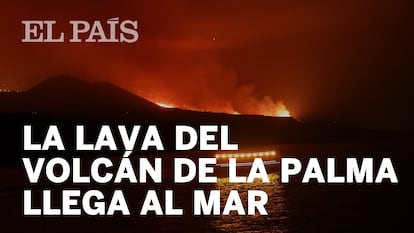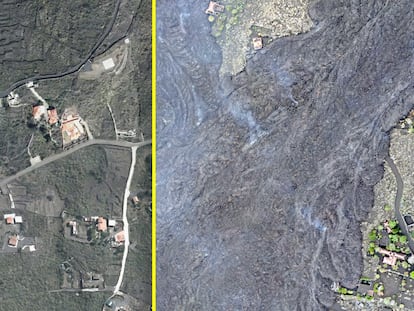Lava from the volcanic eruption on La Palma reaches the sea
The main concern of the authorities now is that toxic clouds created by contact between the molten rock and the ocean could spread to the Canary Island
Lava from the new volcano on the Canary Island of La Palma reached the sea last night at around 11pm local time, at the area known as Los Guirres beach, also known as Playa Nueva (New Beach). There, the molten rock fell from a cliff some 100 meters high. The contact with the seawater created a plume of black smoke, which drifted onto land due to the winds that blow at night from the sea toward the island. The water has little depth in that area, meaning that a new platform was likely to be created relatively quickly.
A group of marine geoscientists from the Spanish Oceanographic Institute who are monitoring the advance of the lava in real time explained last night that “a dramatic deposit measuring more than 50 meters high” was created in less than 45 minutes, and was still growing last night.
Just before 10pm on Tuesday, the Volcanology Institute of the Canaries (Involcan) announced that the tongue of lava had already crossed the coastal road located next to Montaña de Todoque, which is 320 meters above sea level, in the municipality of Tazacorte. The distance separating the coast from the road is around one kilometer. This was the last major obstacle that the lava flow faced before it reached the Atlantic Ocean. Cutting off this road left the Tazacorte neighborhoods of Puerto Naos, El Remo and La Bombilla practically cut off. That said, the island council had created alternative routes to reach these settlements.
Amanece en La Palma y comienza a formarse un delta de lava que poco a poco gana terreno al mar. pic.twitter.com/KNg6jy5Y4K
— Instituto Español de Oceanografía (@IEOoceanografia) September 29, 2021
A tweet from the Spanish Institute of Oceanography (IEO) showing the lava entering the sea.
After passing the Montaña de Todoque, the lava accelerated, given the barren terrain. On its path, it devoured a number of banana plantations, which thrive on the fertile earth in the area.
On Tuesday, the island of La Palma registered a total of 29 earth tremors in different areas, from Villa de Mazo and Fuencaliente, to El Paso, with intensities measuring between 2 and 3.3 points on the Richter scale.
The arrival of the lava in the ocean is something that has been worrying the authorities since the eruption began on Sunday, September 19, given that the molten rock will react with the saltwater to create toxic clouds. The only person to die during the eruption of the Teneguía volcano on the island in 1971 was killed by the inhalation of these gases. For this reason, the work of the Civil Protection force was stepped up yesterday, as the “explosions and the emission of harmful gases” could be seen, according to the Pevolca crisis committee.
The path the lava has taken to the sea, a destructive journey lasting 10 days and leaving around 50 million cubic meters of lava in its wake, has been erratic and unpredictable. After several days of deceleration, the flow reactivated on Sunday, its speed picking up. This situation prompted the emergency confinement of four residential areas due to the danger of toxic gases. These gases are now the main concern of the authorities, who have set an exclusion zone of two nautical miles around the area.
The contact of lava and seawater triggers a chemical reaction, mainly of chlorine, which can irritate the skin, eyes and respiratory system. According to the US Geological Survey, there are four main dangers associated with lava entering the ocean: “The sudden collapse of new land and adjacent sea cliffs into the ocean, explosions triggered by the collapse, waves of scalding hot water washing onshore and a steam plume that rains hydrochloric acid and tiny volcanic glass particles downwind from the entry point.”
There is also the possibility that the sea will turn turquoise green, forming an enormous stain that is visible from space. This is what happened in Hawaii in 2018 following a volcanic eruption.
The eruption has forced the evacuation of more than 5,000 people, destroyed around 500 buildings and razed 200 hectares of land on an island that relies mostly on agriculture. Local authorities have estimated the damage to infrastructure at more than €20 million. King Felipe VI, Queen Letizia and Prime Minister Pedro Sánchez flew to the area last week to survey the damage and speak with affected residents.

The Spanish Cabinet on Tuesday declared La Palma a disaster zone and released up to €10.5 million in aid for the Canary Islands, aimed at financing home purchases and essential items for residents who have been affected by the eruption, some of whom have lost their homes and possessions. The properties will be bought by the regional government of the Canary Islands and assigned to families whose homes were lost or damaged.
The volcano erupted on September 19 after scientists recorded a series of small tremors for a whole week in southwestern La Palma, under a mountain range known as Cumbre Vieja, leading them to believe there could be magma pushing under the surface of the earth. This seismic activity gradually migrated to the surface: at first, the earthquakes were recorded at a depth of 20 kilometers, but in the two days before the eruption, they were felt only 100 meters underground.
The Canary Islands, a volcanic archipelago located off the northwestern coast of Africa, have a history of eruptions. The longest one on record in La Palma took place in 1585 and lasted 84 days; the shortest one dates to 1971 and extended for 25 days. There was also an underwater eruption off the island of El Hierro in 2011. Eruptions in the Canary Islands tend to take the form of fissures: the earth cracks open and lava, gases and other matter start to come out from several points along it.
Even when the eruption ends, residents who were evacuated from their homes will not be able to go straight back to normal. First, the land will have to cool down and stabilize. Any infrastructure left standing must be checked for damage. Toxic-gas levels and ash accumulation will need to be measured, among other parameters. The danger maps establishing if and when displaced people may return to their homes will analyze the risks posed by lava flows, ash, pyroclastic flow (solid particles spewed out by the volcano), gas emissions, lahars (mudflow) and tsunamis. Earthquake activity and ground deformation will also be taken into account, as well as concentrations of carbon dioxide and sulfur.
English version by Simon Hunter and Susana Urra.
Tu suscripción se está usando en otro dispositivo
¿Quieres añadir otro usuario a tu suscripción?
Si continúas leyendo en este dispositivo, no se podrá leer en el otro.
FlechaTu suscripción se está usando en otro dispositivo y solo puedes acceder a EL PAÍS desde un dispositivo a la vez.
Si quieres compartir tu cuenta, cambia tu suscripción a la modalidad Premium, así podrás añadir otro usuario. Cada uno accederá con su propia cuenta de email, lo que os permitirá personalizar vuestra experiencia en EL PAÍS.
¿Tienes una suscripción de empresa? Accede aquí para contratar más cuentas.
En el caso de no saber quién está usando tu cuenta, te recomendamos cambiar tu contraseña aquí.
Si decides continuar compartiendo tu cuenta, este mensaje se mostrará en tu dispositivo y en el de la otra persona que está usando tu cuenta de forma indefinida, afectando a tu experiencia de lectura. Puedes consultar aquí los términos y condiciones de la suscripción digital.
More information
Últimas noticias
Most viewed
- Reinhard Genzel, Nobel laureate in physics: ‘One-minute videos will never give you the truth’
- Oona Chaplin: ‘I told James Cameron that I was living in a treehouse and starting a permaculture project with a friend’
- Pablo Escobar’s hippos: A serious environmental problem, 40 years on
- Why we lost the habit of sleeping in two segments and how that changed our sense of time
- Chevy Chase, the beloved comedian who was a monster off camera: ‘Not everyone hated him, just the people who’ve worked with him’












































